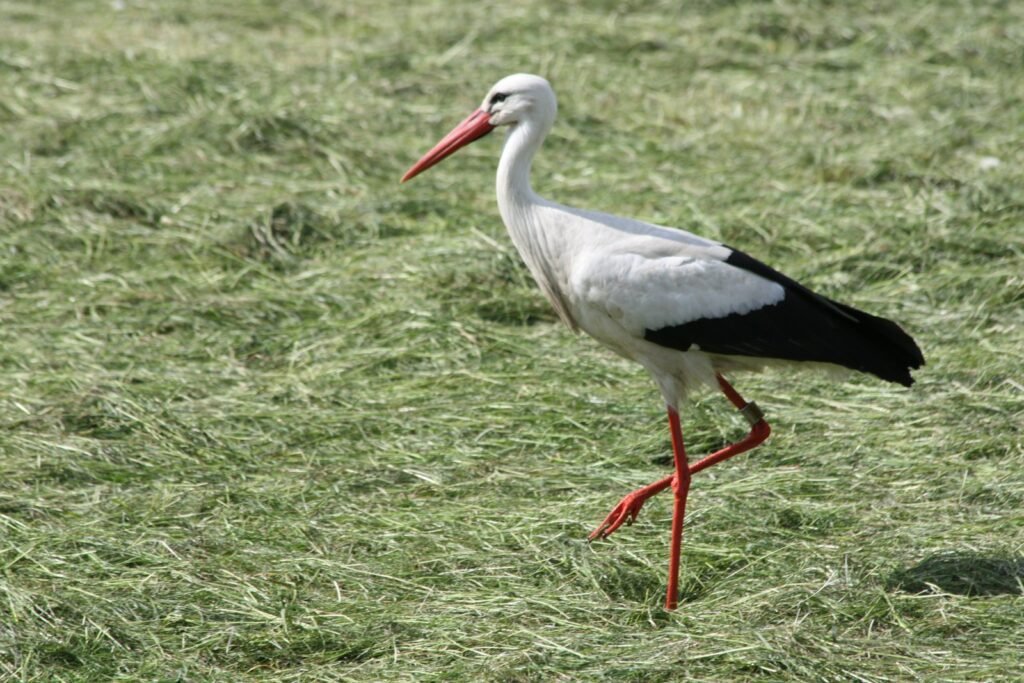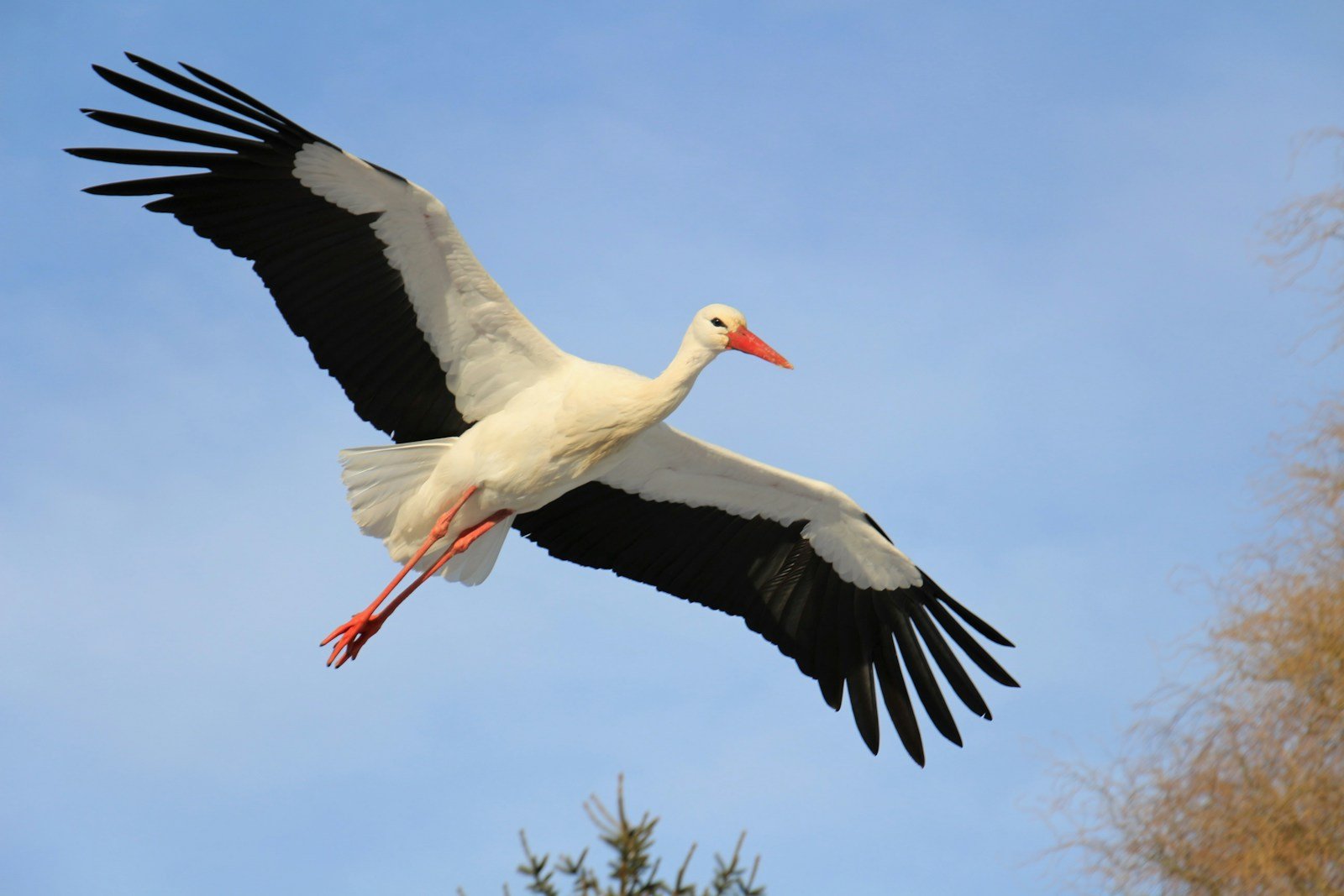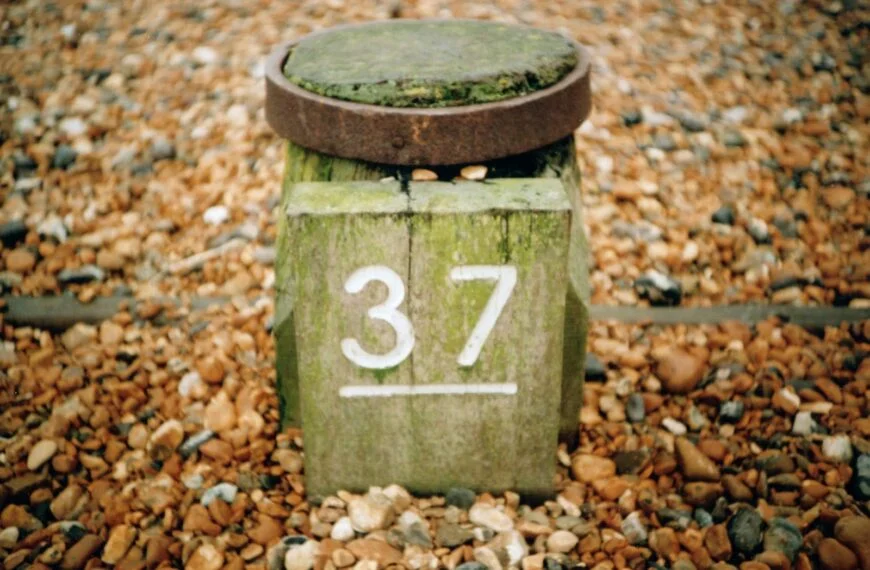In the ancient times in Palestine, near Lebanon’s cedars, white storks made their home. These big birds with 7-foot wings were hard to miss. Everyone admired them for their beauty and grace.
Known as creatures of loyalty, storks are fearless yet loving. They were called “chaidhah” in Hebrew, a term meaning kindness and mercy. This shows their caring nature toward their own kind.
There’s a popular belief they bring newborns to houses, symbolizing love and safety. This story shows their reputation for care and love is far-reaching.
In the Bible, their migratory patterns are noted in Jeremiah 8:7. They travel south to Africa for winter, return briefly to Palestine, and go as far as England. This regular journey is highlighted.
Psalm 104:17 paints a vivid picture of them nesting among Lebanon’s cedars, finding comfort and safety there.
With their large size and commanding presence, storks are respected. They signal the changing seasons in Europe by their arrivals in summer.
They symbolize changing weather by heading south before cold times. This reflects on life’s constant change, urging adaptation.
Storks carefully build their nests. These structures are large, flat, made of sticks, showing their detailed work.
They lay big, yellowish eggs, like those of geese, symbolizing new life within their family.
Storks eat various foods like frogs, fish, and serpents. Though not loud, they’re recognized by the sound of their bills clapping.
At night, storks sleep standing on one leg. Their heads tucked, they find rest yet remain alert.
What does stork symbolize in the Bible? In the Bible, storks hold a special place for reasons including not being eaten by Jews. This signifies their sacredness.
Storks are praised for their gentle ways, shown in caring for their own and the elder birds. Acts of kindness within their species are well-documented.
The stork’s biblical meaning is rich, symbolizing love, protection, and the sacredness of life. Their flight and care echo the values of love and balance of nature.
The Symbolism of Stork in Christian Tradition
The stork is rich in symbolism for Christians. It stands for innocence, modesty, kindness, and loyalty. The Virgin Mary’s purity and grace were also linked with the stork in early Catholic tradition.
Storks are faithful to their mates, even when apart in winter. This is seen as a lesson in loyalty, in both love and religious faith. Their commitment is truly inspiring.
The role of storks in eating snakes and rats was noticed by the Ancient Greeks. This made them symbols of protection and was key in their culture. Killing a stork was a crime punished by death, showing how much they valued their protective nature.
Storks and the Virtue of Kindness
In Hebrew, the stork is linked to the word “chaidhah,” meaning kindness. Christians see this as a call for compassionate action, as an important virtue. This idea fits well with its meaning in the Bible.
Storks care deeply for their families. Their example highlights the Bible’s emphasis on grace, goodness, charity, and mercy. Such virtue is discussed often in the Bible, showing its critical role in a righteous life. It is closely tied to the concept of “chesed” in the Bible.
“Long Suffering, and Abundant in Goodness” is a phrase used in Psalms that reflects the divine qualities associated with the stork’s symbolic significance.
The stork’s meaning in Christianity runs deep. Yet, there’s no direct biblical reason for its special status. This mystery adds to its allure, especially for those sharing in religious beliefs.
Mary’s connection with the stork is another layer of its symbolism. It is a theme that transcends different religious and cultural borders. The stork has a universal appeal, touching hearts globally.
The Stork’s Symbolic Significance
The stork’s symbolism reflects purity, loyalty, and kindness. Christians see it as a guide to living a virtuous life. It stands as an enduring symbol of spiritual values.
This bird serves as a reminder to Christians. It challenges them to aspire to the virtues it represents. Christians see the stork as a symbol of their faith and the good they should strive for.
The Symbolism of Stork in Hebrew Tradition
In Hebrew tradition, the stork is called chasida, which means kindness or mercy. It comes from the word “chesed” in Hebrew. This word represents goodness, grace, charity, and mercy. The stork’s virtues match the biblical idea of “chesed,” showing these qualities are very important.
The Hebrew prayer “E•rch A•pa•yim veRav Che•sed” talks about the plenty of goodness. It uses the stork as a symbol of kindness and a carrier of divine mercy.
Moses notes in Exodus 34:6 that God is merciful and full of goodness. Psalms also highlight God’s loving-kindness (Psalm 86:15 and 103:8).
The stork shows love as it cares for its young.
We don’t know why the Bible calls the stork ‘chasida.’ But the stork’s actions show it’s a good symbol for kindness.
In Leviticus 11:19 and Deuteronomy 14:18, the stork is listed among the birds. This shows the stork’s recognition during biblical times.
Symbols Unveiled: A Vision of Wings
Zechariah 5:9 talks about two women with stork-like wings. This vision links the stork with divine protection and deliverance. It highlights its faithfulness.
The stork is seen as a bringer of godly mercy and grace, helping those in need.
The stork’s travels include trips to Africa and through Palestine and Europe. Its migration shows its universal symbolism. This pattern signifies its dedication and purpose.
Historical writings show the stork was once a favorite dish. Yet, other texts considered it unclean. This mix of views adds to the stork’s varied meaning across cultures and times.
The stork’s meaning in Hebrew tradition focuses on kindness and mercy, reflecting divine virtues. This shows the value of these qualities in biblical teachings.
The Stork’s Parental Care and Filial Attachment

The stork is known for its amazing care for its young and strong family bonds. Stories from history highlight the stork’s willingness to protect its nests no matter what. This shows us the deep bond between family members and the sacrifices parents make for their children.
“The stork’s commitment and tenderness towards its young are truly awe-inspiring. This love shows the importance of family ties and the care found within them.”
These birds symbolize the idea of taking care of one another across ages. They help their aging parents, showing a beautiful cycle of care. This care over generations is a prime example of looking after family members throughout their lives.
Young storks stay in the nest for a long time before flying off. During this time, they learn everything they need for life. It’s all about making sure they are well-prepared to face the world alone.
The stork’s care for their young and elderly highlights strong, lasting family connections. Their actions emphasize the importance of putting family first, always. It shows us the true meaning of building and maintaining strong family bonds.
Biblical References to the Stork
The Bible talks about the stork in many places. In Leviticus 11:19 and Deuteronomy 14:18, it’s seen as an unclean bird. This means it was off-limits for the Israelites to eat. This shows that in those days, people knew storks were a special kind of bird.
Jeremiah 8:7 compares the stork’s moving habits to heavenly timing. This points to how the stork’s faithfulness to move everyone connects with the idea that people should also stick to God’s laws.
“The stork in the heavens knows its appointed times; and the turtledove, the swift, and the swallow observe the time of their coming. But my people do not know the judgment of the Lord.” – Jeremiah 8:7
The Book of Psalms talks about where storks make their homes. Psalms 104:17 mentions storks nest in Lebanon’s fir-trees. This shows how closely tied the stork is to trees and mountains.
These parts of the Bible teach us about storks. They tell us how they live, travel, and their deeper meaning within ancient beliefs.
Protection and Reverence for the Stork
The stork is a special bird that has been highly valued throughout history. People appreciate its unique traits. These include how it cares for its offspring. This has led to making laws to protect the stork.
In ancient times, folks noted how loyal and brave storks were. They symbolize love and family. The city of Thessaly even made it illegal to kill storks because they ate snakes and kept people safe.
Over the years, people’s affection for the stork has grown. This has resulted in rules to protect them. These laws aim to keep the stork’s homes safe and help them thrive. They show that society values storks and wants them to live on.
Storks have become symbols of many good things in different cultures. They are seen as loyal and full of love. Also, their help in keeping pests under control is very appreciated. This has made people love and protect storks even more.
To wrap it up, the stork is treasured for its faithfulness and its care for its own. The laws made to guard storks underline their importance. Storks are seen as key to nature and worth preserving for the future.
The Stork’s Habitat and Nesting Habits
Storks are picky about where they live and build their nests. The white stork, back in the UK after six centuries, nests in trees. On their way to Europe, some stop in Palestine. But others fly all the way, choosing rooftops and special spots in England for their homes. The black stork opts for wet, wooded areas for its nests. This includes areas in Palestine as well.
This helps link storks with houses and the idea of them bringing babies. Seeing storks on roofs or in trees is seen as good luck in many stories and customs.
The Stork’s Nesting Preferences and Symbolic Associations
“The white stork often nests in trees in Palestine, while the black stork prefers marshy places in forests. Their nesting choices have given rise to the symbolic association of storks with homes and the delivery of newborn children.”
Nesting isn’t just about what storks like. It also shows their incredible memory and ability to find home again. These birds know where their nests are and come back to them. This skill helps them be safe and raise their young well.
In the UK, people have worked hard to welcome storks back. Conservationists have made their old homes suitable again. Now, storks can live and have babies in places full of history and meaning.
Storks’ picky habits and nesting show they’re devoted and adaptable. They keep finding good spots to live. This reminds us to take care of the places they need to survive, for our future and theirs.
The Stork’s Diet and Features
The stork is known for its standout look. It features black and white feathers, a red bill, and long legs. With a large wingspan, storks are beautiful and skilled. Their diet is quite broad, including moles, mice, and even fish. This allows them to live in many places, catching both land and water animals.
Surprisingly, storks are similar to cranes in what they eat. Both birds enjoy a meal of fish and small creatures. But cranes also like carrion. This is dead animals and things that smell bad. The difference in what they eat might be why storks are not considered clean in some religious texts, like the Bible.
Storks are very good at finding food in different ways. They can look for mice in grassy areas. Or they might stand still near water, waiting for fish. Their ability to eat many things helps keep nature in balance. By eating some animals, they prevent others from becoming too many.
The Stork’s Migration Patterns and Timing
Storks are really something when it comes to flying off to places. They spend their winters in Africa. Then, in the spring, they take off. They fly over vast distances, even stopping in Palestine. This is before they head to Europe, reaching places like England.
In the Bible, Jeremiah 8:7 talks about how storks know exactly when to start their journeys. They always come back to the same places. What captures our imagination is how they begin their flights together.
Storks are just part of the millions of birds that fly over Israel. They stop there to rest and eat on their way somewhere else. About 500,000 of these birds, including storks, make a big stop in Israel. It shows how important this country is for their long trips.
Storks are pretty tough, making it through all kinds of places and weather. They fly high over open areas or across long distances. They can travel thousands of miles gracefully and precisely. It’s absolutely amazing to watch.
Storks, with their migration patterns and timing, create unforgettable sights and remind us of the effortless wonders of the natural world.
Watching the storks fly isn’t just about seeing birds move from one place to another. It makes us think about life’s cycles and the chance for new beginnings. When they come back in spring, it’s like life is waking up again.
Storks were missing from Britain for 600 years, and then they came back. People have different ideas about what this means. Some say it’s a sign of hope for the Christian religion. Like the storks, we should always stay true, especially in our beliefs.
The storks’ migration patterns and timing evoke a sense of wonder and embody the themes of faithfulness, migration, and new beginnings.
History, studies, and religious writings have looked into the stork’s migrations. Places like The Guardian, BBC, and Haaretz have shared what they’ve learned. It helps us see how important the storks are in their long journeys.
Storks can cover a lot of distance and always know where they’re going. They show us how all parts of nature are connected. And they remind us of the need to protect the places they fly over.
When we think about the storks and their movements, it shows us the beauty in nature. It’s a message of hope and new chances that we can all learn from.
Stork Symbolism in Other Cultures
The stork isn’t only meaningful in religious and biblical texts. It’s seen as a sign of good fortune, faithfulness to the family, and new beginnings in many myths. In ways unique to various places, storks are tied to the idea of mothers being devoted to their children.
In Egypt, the stork was linked to starting over and coming back to life. As it flew home in spring, it brought the promise of fresh starts and growth. For the Chinese, storks symbolize a long life and luck, representing a life in balance.
Seeing a stork is often seen as a good sign in many places. They’re admired for their long journeys and how they keep their elegance. This is seen as a lesson to go through life’s changes with grace.
The stork is found in stories across the world, symbolizing wisdom and a deep connection to family. It stands for lasting love and loyalty, as these birds stick with one partner for a long time. This makes it a respected figure everywhere.
Storks in Art, Literature, and Pop Culture
The stork has left its mark on art, stories, and even superhero tales. It’s been part of religious pictures, ancient writing, and today’s comics. In these forms, the stork’s role shows how it’s been valued through history.
From ancient myths to today’s culture, the stork’s symbolism remains. It’s known for bringing fertility, purity, and good fortune. Its themes of new beginnings, faithfulness, and spiritual change make it important in many cultures.
The Stork in Nature and Conservation Efforts
Storks are vital for keeping nature in balance. They help control the number of rodents, snakes, and other small creatures. This makes sure areas are healthy and varied. Storks show us how well wetlands and forests are doing.
Yet, these big birds are facing tough times today. They are losing their homes to development, are harmed by pollution, and disturbed by people. In the past, white storks in Britain disappeared because of these problems.
Many people have worked hard to bring white storks back to Britain. Their efforts paid off when these birds nested in May 2020. This was the first nesting in 600 years. Bringing storks back aims to protect their homes and teach others about their importance.
Today, storks are not at immediate risk of dying out, according to experts. But we must still protect the places that storks and many other animals live in. Doing so helps not just the birds but also our planet.
Conclusion: Meaning and Significance of the Stork in the Bible
The stork means a lot in the Bible. It stands for good things like innocence, kindness, and loyalty. In Jeremiah 8:7, it shows us deep spiritual messages. Its wings are for quick and strong flying, showing how God’s punishment is fast and sure.
Zechariah’s vision talks about a woman and the bad Jewish nation. It hints that removing the woman is like punishing or exiling the Jews. The stork’s wings show that God’s punishment can’t be stopped, and sins will lead to consequences.
These stories are a warning about God’s judgment and what happens if people keep doing bad things. They say it’s time to turn back to God. Scholars look at these stories and connect them to the past, like when the Jews were taken away by Babylonians.
The stork in the Bible tells us to see God’s signs around us. It shows nature’s wisdom and how people sometimes miss God’s message. The stork, with its nurturing side and strong flights, is a sign of God’s judgment, but also a way for people to seek spiritual forgiveness.
FAQ
What does stork symbolize in the Bible?
In the Bible, the stork has spiritual meaning. It stands for innocence, kindness, and loyalty. Mercy is also linked with the stork.
What symbolic meanings does the stork have in Christian tradition?
For Christians, the stork represents purity and kindness. It symbolizes the Virgin Mary and a strong faith.
What is the symbolic significance of the stork in Hebrew tradition?
In Hebrew tradition, the stork means kindness, similar to “chesed” in the Bible. It reflects goodness and mercy.
How is the stork’s parental care and filial attachment celebrated?
The stork is praised for its family devotion in many cultures. This bird symbolizes selfless love and strong family ties.
Are there any biblical references to the stork?
Yes, the Bible talks about the stork. It’s seen as unclean in Leviticus and Deuteronomy. Jeremiah mentions its faithfulness to God’s laws.
How has the stork been protected and revered throughout history?
The stork has been valued for its parenting and loyalty. Laws against killing show early protection efforts for this bird.
What are the nesting habits of the stork?
The white stork nests in trees in Palestine. The black stork likes marshy forest areas. These habits connect the stork to homes and birth.
What do storks eat, and what are their distinguishing features?
Storks eat moles, mice, and fish. They have unique black and white feathers. They also have a red bill and legs, with a long wingspan.
What are the migratory patterns of storks?
Storks migrate across Africa and Europe. They stop in Palestine, showing their incredible timing and migration patterns.
How is the stork symbolized in other cultures?
Many cultures see the stork as a sign of new life and luck. It means rebirth in Egypt and brings longevity in China.
What role do storks play in nature, and what conservation efforts are in place?
Storks help control pests by eating rodents and snakes. Conservation efforts involve protecting their habitats and educating people about their role in nature.
What is the meaning and significance of the stork in the Bible?
In the Bible, the stork is rich in symbolism. It signifies important virtues like innocence and loyalty. The stork’s value spans across cultures, echoing its timeless lessons.

Rockin’ the faith, one verse at a time!
Growing up, the Bible’s stories deeply impacted me. Now, with over 15 years of preaching experience, I blend timeless teachings with modern technology, making them relevant for today’s world.
Bible Hub Verse is my platform to share historical insights and thought-provoking articles, exploring both familiar and uncommon Christian topics. My passion is building a welcoming online space for everyone to learn, grow in their faith, and discover the Bible’s enduring message.
Join the journey!
God bless you.







